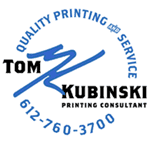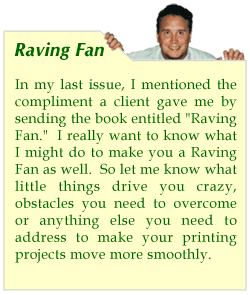

Tom Kubinski
Printing Consultant
tkubinski@sextonprinting.com
Direct: (651) 255-1225
Fax: (651) 457-7040
Cell: (612) 760-3700

 Mary Albers
Customer Service
mkc@sextonprinting.com
Direct: (651) 255-1255


 www.sextonprinting.com
250 East Lothenbach Ave.
Saint Paul, MN 55118
Phone: (651) 457-9255
Fax: (651) 457-7040
Toll Free: (800) 388-2914

File Issues
Prepress
UV Burn
Ink Tour
Paper Mill Tour |
|
 |
October 2001 TK's Korner
9th Annual Paper Mill Tour recap-Potlatch in Cloque
It definitely was the best tour yet! We started our trip with many nail-biting games of Taboo. By the time we arrived at the Potlatch paper mill, the left side of the van was one game ahead. The final outcome was that the left side absolutely kicked the right side's tail by the time we returned home.
See photos from the tour
Our first stop was the Nursery. Here we learned many interesting things!
- Potlatch has 350,000 acres.
- Every year Potlatch grows twice as many trees as they harvest.
- Harvesting of a paper tree does not occur until it is about 60 years old.
- Harvesting of a board tree like a hybrid poplar occurs around 15-20 years.
- The hybrid poplar tree grows about 12 feet a year.
- Minnesota has nearly 12 million more large trees (>19" diameter.) today than it did 30 years ago.
- Only 1% of Minnesota forestland is harvested annually.
- Potlatch donates 50,000 tree seedlings a year.
- Potlatch raises two crops of tree seedlings, about 1.3 million seedlings total, each year in its greenhouse.
- It's possible to grow a "3-year" seedling in 1.5 years with technology.
- Each container (see photos) holds about 198 1-year-old seedlings.
- Softwoods are used to give strength to paper. Softwoods include Norway pine and other conifers.
- Hardwoods are used to give smoothness to paper. Hardwoods include maple, poplar, aspen, and other trees with leaves.
 The Wood-Room was next. Here we saw some really cool things.
The Wood-Room was next. Here we saw some really cool things.
- 250 trucks a day bring logs in to be processed.
- 60 million tons of chips are in each pile, and there are about 8 piles.
- Each pile lasts about 3 days.
- The tumbler, a huge cylinder that reminded me of the tunnel that the Six Million Dollar Man runs through in his opening scene, is supported by about 10 huge airplane landing gear tires, which allow it to spin. The logs are run through this spinning tumbler to remove the bark.
- Once the bark is removed, the logs move onto a conveyer belt that runs under a very sensitive metal detector. We saw one huge trunk with a horseshoe in it and one with a spike in it.
- The logs then move to a very serious and extensive knife cutting/chipping area.
- Chips are sorted by size by these two huge shakers that move side to side.
- Then comes the huge, I mean huge, piles of chips outside that lay in wait for the selection process pertinent to each specific brand of paper.
The Mill itself.
- Operates 7 days a week, 24 hours a day, 363 days a year.
- Pulp is always made the same, no matter which type of tree is used.
- What they add to the pulp and paper machine dictates what kind of base stock the paper is.
- The type of coating formula used dictates what type of paper is produced.
- Master rolls--Parent rolls--Jumbo rolls are each 40,000 lbs., 192" wide by 100" in diameter.
- They produce 650 tons, or 35 parent rolls, a day
- Broke-A) Anything excess, B) Off Quality standards, C) Transition base stock D) Transition coating, etc. They intend 35% as internal broke.
- 10% post-consumer waste is typical.
- Each sheet has a wire side and a felt side. The wire side is smoother and harder than the felt side.
- From start to finish, the papermaking line is 200 feet long.
- The process starts at 99% water and ends up at 4% water. The drain-press-evaporate process removes 80% of the water.
- The coating goes on one side at a time. The knives that are used to smooth out the coating are something else.
- Super calendaring is the process of buffing the coating or polishing it to the desired finish; for example silk, velvet, dull, or gloss.
- Matte stocks are not calendared at all, and that is why they tend to scuff.
- Testing for physical, optical, color, etc., is done for every reel at different stages: A) Off the paper machine, B) Off the coater, C) Off the super calendar
- Potlatch in Cloque produces the following types of paper: Vintage, Scout, Northwest, McCoy, and Mountie. They make everything every week.
- An extensive tracking system is in place. It can trace back a skid of paper from a printer to its parent roll, date produced, by whom, conditions, etc.
- Cartoning and labeling occur in one smooth process.
- Press-ready skids that Potlatch produces are awesome. There are slots in these skids that allow the pressman to simply load and go. Great Idea!
- Potlatch also has some really good tools for us to use: the Potlatch Guarantee and the Potlatch Problem Solver Guide.
- We even received our very own sample of pulp.
Stay tuned for the next TK's Korner. You never know what might be covered next. If you would like to join me on the next paper mill tour, or if there is something that you would like me to address, or you know of someone who might like to receive TK's Korner, please let me know via e-mail at tkubinski@sextonprinting.com or phone. Take care and have a great day.
Successfully,
 Tom Kubinski-Printing Consultant Tom Kubinski-Printing Consultant |


 The Wood-Room was next. Here we saw some really cool things.
The Wood-Room was next. Here we saw some really cool things.

